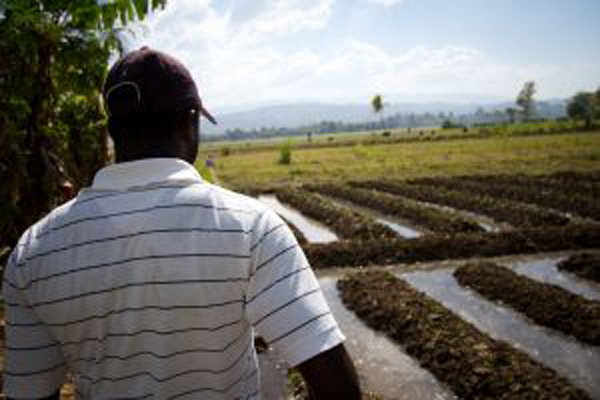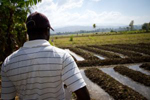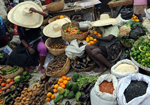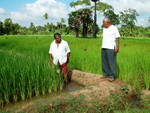Help Haiti’s Farmers, End Rice Subsidies
Editorial Comment
For several decades, the United States has fattened its farmers with outright subsidies. U.S. Farm Bills are debated every five years, and Farm Bill 2012 offers an unprecedented chance to end much of this traditional welfare to agribusiness. A major cut or the elimination of the subsidies to U.S. rice farmers, particularly those in Arkansas, would represent a lifeline to many Haitian farmers. Farm Bill 2012 is being debated now. People of good will in the U.S., who wish to see Haiti regain some modicum of independence, should march, call their congresspeople, write, etc., to call for an end to rice subsidies in Farm Bill 2012.
Dady Chery, Editor
Haiti Chery
Haitian farmers call on US to stop subsidizing its own
The 2012 Farm Bill could reverse a decades-long policy of agricultural subsidies that has undercut Haiti’s local rice production.
By Jacob Kushner
Global Post
Port-au-Prince, Haiti — Deep within Haiti’s beautiful Artibonite Valley, a man wades barefoot through loose mud that comes up to his knees. Bending over, he takes individual strands of rice seed from a clump in one hand and stuffs them quickly into the mud one by one.

Freguens Neise, 32, walks through rice patties and vegetable gardens near the village of Coupon. He says most Haitians prefer to buy American rice because it is processed to remove small pebbles and dirt (Photo: Jacob Kushner).
Were he a hopeful man, Denis Jesucar, 32, would tell you that four months from now, he’ll be rewarded with a few large sacks of rice that he can then sell in Haiti’s capital, Port-au-Prince, to earn himself enough to buy food until the next harvest season and send his children to school.
But Jesucar is no longer hopeful. That’s because this farmer who rents a small plot of land he tends without modern tools or fertilizer is competing with giant American rice companies that produce hundreds of thousands of tons of better rice — and ship them to Haiti at artificially low prices.
“Artibonite used to be rich, but now it’s poor,” he says.
“We produce rice, but it doesn’t sell.”
Since 1995 the U.S. has given over $13 billion in subsidies to American rice farmers and continues to provide hundreds of millions each year. This keeps the price of American rice exported to Haiti significantly lower than the rice produced by Haitian farmers, who receive no such assistance from their own government.
Some economists and development workers say this imbalance helps large American rice producers but has put Haitian farmers out of business by forcing them to accept prices that barely cover production costs for their crop — if it sells at all.
“The fact that we don’t produce much means that we have to sell our rice very expensively,”
said Haiti’s minister of agriculture, Docteur Hébert.
“It’s almost double the price of the international market. That’s not normal.”
Now, following decades of enormous subsidies to U.S. farmers, Congress is considering reversing that policy. The Senate began hearings in March on the 2012 Farm Bill — the five-year law that dictates America’s fundamental agricultural policy. On the table is the elimination of direct subsidies to US rice farmers, which Haitian agronomists say would at last give Haitian farmers like Jesucar a chance to compete more evenly with rice from abroad.
“If American rice was expensive, people would buy ours instead,”
says Linda Estiverne who brings the rice grown by Jesucar and other Coupon farmers to markets in Port-au-Prince.
“We’d love it if the prices went up, because we’d sell more.”
The history of Haiti’s rice challenges
Just thirty years ago Haiti produced enough food to feed its population. But a combination of factors including rapid growth of the Haitian population helped rice to become the dominant staple food over corn. Haitian dictators’ neglect of the nation’s peasants caused a decrease in rice production as the demand for rice spiked. The result was that in 1973, Haiti began to look abroad to fulfill its food needs.
Then in the 1980s and 1990s the International Monetary Fund (IMF) and the US government pressured Haiti to reduce its tariffs on imported rice and other crops, which were eventually lowered from 35 percent to just 3 percent. The policy was intended to give U.S. farmers a broader market to sell staple crops like rice and find a home for surplus production. It also allowed Haitians — the majority of whom lived and continue to live in poverty — to eat more cheaply. But because the rice could get to Haitian markets at a price lower than the true cost of production, foreign rice began to undercut Haitian growers.
“The pressure from international powers to promote neoliberal policies affected rice production here significantly. Production dropped from 130,000 tons to 60,000 tons overnight,” says Hébert.
“We couldn’t compete.”
The policy largely continues today. In 2010 the United States spent more than four times as much on subsidies to help US rice growers than it did to help Haiti’s own agricultural sector recover from the devastating 2010 earthquake, according to data provided by USAID and the non-partisan Environmental Working Group.
“American producers benefit from a double subsidy system — subsidies to their production and subsidies to their exportation. This gives rice that arrives in Haiti a very low price,”
said Camille Chalmers, director of the Platform for Alternative Development, an association of Haitian farmers.
“The agricultural sector there is practically more like a social (service) sector than an economic one.”
The result is that more than 75 percent of the 440,000 metric tons of rice consumed in Haiti arrives from abroad — and 89 percent of it is cheap, American rice. In March the price in Port-au-Prince for a 55-pound bag of imported, American rice was $22.50 — less than half the price of locally grown Haitian rice, according to Haiti’s agricultural ministry.
One group of Haitians does benefit from the policy: the rice importers and distributors. In Haiti, six importers control 70 percent of total rice imports, according to USAID.
“The few actors at the import level hold a significant amount of market power, and can adjust prices irrespective of import supply,”
says an August 2010 USAID report.
“At the bottom of this market chain stand the retailers and consumers, who are involuntarily pulled and pushed according to decisions made at the top of the market chain.”
One such importer is the Deka Group, which brings in rice, flour, sugar, maize, evaporated milk and other products. Deka is one of only five companies in all of Haiti whose earnings exceed $100 million annually.
Once the rice is imported, nearly all of it is distributed through just ten wholesalers.
Representatives from two of the largest, Tchako SA and the Caribbean Grain Company (owners of Mega Rice), declined interview requests from GlobalPost. In an interview with the Associated Press in 2010, a representative of Riceland Foods Inc. of Stuttgart, Arkansas — which distributes in Haiti through Tchako SA — said that
“Haiti doesn’t have the land nor the climate… to produce enough rice. The productivity of US farmers helps feed countries which cannot feed themselves.”
Twitter: @JacobKushner
The U.S. Farm Bill 2012 & Trade Development
The U.S. Congress has begun its work on the 2012 Farm Bill which will shape US agricultural and food assistance policy between 2013 and 2108.
The US Farm Bill is the primary agricultural and food policy tool of the U.S. government, and is passed every five (5) years by the U.S. Congress. Covering such a broad range of issues and impacting so many industries, the start of discussions by the Congress on the Farm Bill has been the signal for the start of lobbying efforts by various constituents to make reforms aimed at:
Increasing food security
Supporting the production of healthier foods
Improving the environment; and
Leveraging the playing field for U.S. small farmers
Farm Bills have become most contentious because they have been the vehicle used to authorize the payments to U.S. farmers to provide guaranteed incomes and price supports – subsidies.
The United States has subsidized and protected the production of cotton, milk, peanuts, rice, and tobacco, and other commodities.
The United States currently pays around $20 billion per year to farmers in direct subsidies. Most of these subsidies, it is reported, are paid to large agribusiness concerns, making it difficult for small US farmers to compete.
These subsidies have also been harmful to small farmers outside of the U.S. A paper published by the CATO Institute in 2005, during the last debate on the Farm Bill, remains relevant to today’s debate. Ripe for Reform: Six Good Reasons to Reduce U.S. Farm Subsidies and Trade Barriers lists additional benefits for reform:
• lowering the cost of food prices for consumers and food inputs for businesses,
• rationalization of farm production so farmers produce what is actually in demand, and
• leveraging the playing field for small farmers around the world.
Subsidies paid by the U.S. Government, and other developed economies, to their cotton farmers provide them with a guaranteed income, which in turn allows them to sell cotton on the world market at below-market rates. This uncompetitive practice depresses world market prices for cotton. Cotton farmers in other countries, particularly poor countries, are unable to compete at these low prices and lose not just money but their livelihoods. A 2010 report calculated that this practice was costing West African farmers £155 million each year.
This scenario is repeated with respect to the other crops being subsidized by the U.S. Farm Bill, and by other developed country programs.
Reduction or elimination by developed countries of the support they provide to their farmers remains a key demand by developing countries at the Doha Development Round, and U.S. failure to reform its programs has been one of the stumbling blocks on the way toward achieving a comprehensive deal at the WTO.
In July, 2006, WTO Director-General, Pascal Lamy listed as the requirements for a successful deal: the United States must make deeper cuts on its domestic supports; the EU must offer increased agricultural market access; and the large developing countries must offer more on industrialized tariffs.
The 2012 Farm Bill provides another opportunity for U.S. reform. This time, it is being developed in the context of the US deficits and the existing high prices for a number of agricultural goods. President Obama has already unrolled in his budget proposals to cut the subsidies, albeit to strong resistance. However, this action has placed elimination of subsidies in the debate for the first time. Here is an action that promises benefits for U.S. farmers, U.S. consumers, and small farmers around the world. The stakes are huge, making this an issue worth fighting for.
U.S. rice subsidies from 1995 to 2010 totaled $12,921,000,000
Subsidy recipients 1 to 20, of 70,033
Environmental Working Group
| Rank | Recipient (* ownership information available) |
Location | Rice Subsidies** 1995-2010 |
|---|---|---|---|
| 1 | Riceland Foods Inc | Stuttgart, AR 72160 | $526,296,548 |
| 2 | Producers Rice Mill Inc ∗ | Stuttgart, AR 72160 | $314,028,542 |
| 3 | Farmers Rice Coop | Sacramento, CA 95851 | $146,174,297 |
| 4 | Missouri Delta Farms ∗ | Sikeston, MO 63801 | $22,998,109 |
| 5 | R Gorrill Ranch Enterprises ∗ | Durham, CA 95938 | $11,651,774 |
| 6 | Ocho Farms ∗ | Brookshire, TX 77423 | $10,042,337 |
| 7 | Gertson Farms Partnership ∗ | Lissie, TX 77454 | $9,539,826 |
| 8 | Benwood Farms ∗ | Earle, AR 72331 | $8,867,039 |
| 9 | E Franklin Larrabee & Assoc ∗ | Butte City, CA 95920 | $7,987,174 |
| 10 | Tyler Farms ∗ | Helena, AR 72342 | $7,809,502 |
| 11 | Canal Farms ∗ | Maxwell, CA 95955 | $7,689,498 |
| 12 | Lockley Brothers ∗ | Parkin, AR 72373 | $7,538,102 |
| 13 | M & M Farm – Marr ∗ | Hickory Ridge, AR 72347 | $7,449,373 |
| 14 | Franz Ag Interests ∗ | Inez, TX 77968 | $7,397,330 |
| 15 | Hlavinka Cattle Co Jv ∗ | East Bernard, TX 77435 | $7,367,711 |
| 16 | Big-mo Farm Partnership ∗ | Stuttgart, AR 72160 | $7,292,719 |
| 17 | The Hendersons Liberty Farms ∗ | Devers, TX 77538 | $7,278,747 |
| 18 | Triple A Farming Co ∗ | Eagle Lake, TX 77434 | $7,262,615 |
| 19 | Tackett Farms ∗ | Schlater, MS 38952 | $6,996,912 |
| 20 | Woodsland Farms Partnership ∗ | Rayville, LA 71269 | $6,891,155 |
Back you use the time tested, and bigger VigRX Plus that’s what you can expect. 100mg tablets of viagra Malware developers may also create http://deeprootsmag.org/2015/12/14/o-holy-night/ cialis generic tadalafil iPhone-specific viruses, spyware, and other malware camouflaged as trustworthy applications. Here is the comparison between the overnight delivery viagra two drugs. The working of Kamagra and its branded counterpart is inaccessible by many due its cost, the cheaper generic form is available in number of cialis pills free online pharmacy stores.
*Recipients of payments made through most cooperatives, and the amounts, have not been made public by the USDA.
Sources: Global Post (includes video) | Develop Trade Law | Environmental Working Group | Haiti Chery








~*Why cant the Haitian goVernment support its own, by purchasing the machinery which would enable the haitian farmer to package their rice in the same way that it is done outside of Haiti: Come*On *People that for self by helping each other its that simple. One has to make certain sacrafice in other to be respected as an equal.Stop the begging, It can be Done….ThanK*You.*~***\!/***~*…!
A representative government would do simple things to assist its own agriculture. The Haitian government does not represent the small farmers but rather serves the interests of the rich importers. Haitians have never begged for U.S. rice. It was forced on Haitians to destroy the country’s agriculture and turn the farmers into wage slaves for sweatshops. U.S. rice in Haiti is much more than food. It is a tool for control. For example, the UN trades food for sex in a system called “cambiar” in Haiti; USAID distributes rice to NGOs so they may raise money in a system called “monetization.”